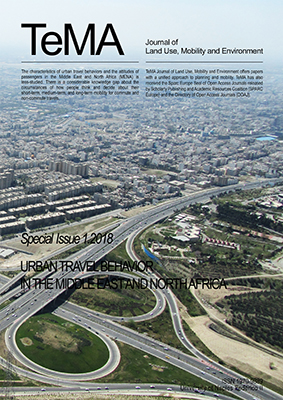Warning
Dear Readers and Authors,
We announce that TeMA Journal is available at the new URL.
Thank you for your continued support.
TeMA Journal Editorial Staff

The characteristics of urban travel behaviors and the attitudes of passengers in the Middle East and North Africa (MENA) is less-studied. When it comes to the effects of urban form, residential self-selections, and lifestyles, it is entirely not investigated in majority of the countries of the region. There is a considerable knowledge gap about the circumstances of how people think and decide about their short-term, medium-term, and long-term mobility for commute and non-commute travels. The we do not know if the land use traits such as population and employment densities as well as mix of land uses, accessibility to public transportation and neighborhood amenities, and connectivity of street networks are as influential as they are in western counties or in higher income societies. There is a very limited understanding about the extent to which the personal preferences, lifestyles, and in general psychology of the people of the region affect their transport behaviors. The complexity of the analysis methods applied for studying urban travel phenomena of the MENA region is even less-developed. Longitudinal or discrete choice molding methods are applied in mobility research considerably less than studies coming from high-income countries.
Warning
Dear Readers and Authors,
We announce that TeMA Journal is available at the new URL.
Thank you for your continued support.
TeMA Journal Editorial Staff
TeMA Journal
Call for paper
TeMA vol. 18 (2025)
TeMA Journal intends to propose articles that deal the effects of global warming, the ageing of population, the reduction of energy consumption from fossil fuels, the immigration flows from disadvantaged regions, the technological innovation and the optimization of land use.
Editor-in-Chief: Rocco Papa | With ANVUR resolution of April 2020, TeMA Journal and the articles published from 2016 are included in A category. | print ISSN 1970-9889 | online ISSN 1970-9870 | © 2008 | Registration: Cancelleria del Tribunale di Napoli, n° 6, 29/01/2008 | TeMA is edited by the Laboratory of Territory, Mobility and Environmental of the University of Naples Federico II | Journal realized with Open Journal System and published by FeDOA - Federico II University Press at Center for Libraries "Roberto Pettorino" | TeMA is indexed in ANCE Catalogue of CINECA MIUR code n. E193096 and in DOAJ Directory of Open Access Journals. The articles published on TeMA are included in main international scientific database as Scopus (from 2023), Web of Science (from 2015) and the Directory of Open Access Journals (DOAJ). TeMA Journal has also received the Sparc Europe Seal for Open Access Journals released by Scholarly Publishing and Academic Resources Coalition (SPARC Europe).
